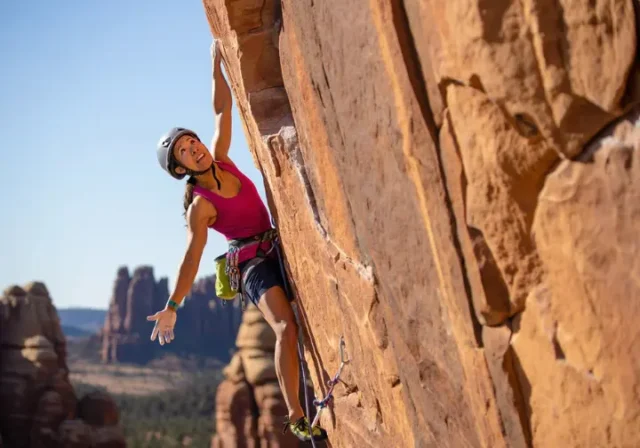In this article
Sport climbing across North America offers an incredible diversity of experiences, drawing climbers to its varied landscapes and unique rock formations. This guide explores what makes a crag a “must-do” destination, from the quality of the rock to the overall adventure it provides. We’ll journey through some of the most celebrated sport climbing spots and climbing areas in North America, each presenting its own blend of challenge and culture.
North America presents a vast spectrum of sport climbing opportunities, from the sun-drenched desert towers of the Southwest to the verdant, cliff-lined forests of the East, and the immense limestone canyons of Mexico; this variety creates a magnetic allure for climbers. Sport climbing, which involves ascending rock faces using pre-placed permanent bolts for protection, allows climbers to focus on movement and the physical challenge, making it an accessible and rewarding pursuit. This approach differs from traditional climbing, where climbers place their own temporary protection as they ascend. The “must-do” crags and top climbing destinations featured in this guide have been selected based on several key factors: rock quality and variety, route density and grade diversity, accessibility and amenities, and their iconic status or aesthetic appeal. Prepare for a tour of destinations that promise unforgettable adventures and incredible climbing challenges for every climber.
Essential Knowledge: Grades, Safety, and Community
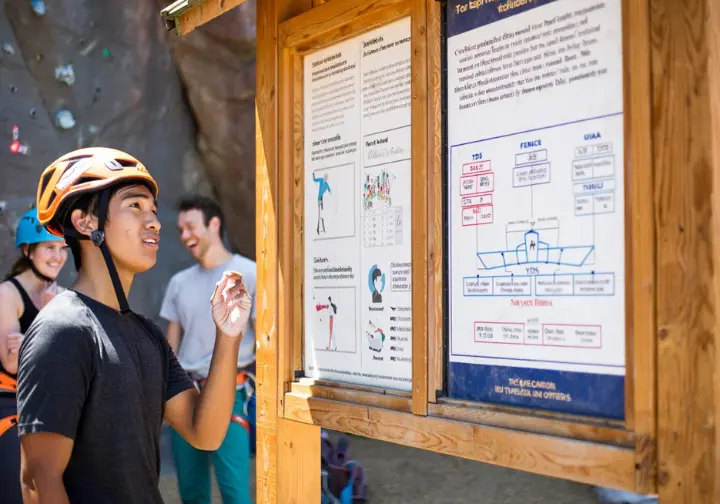
This section covers foundational knowledge for sport climbers, including understanding the Yosemite Decimal System (YDS), key safety considerations, local ethics, and the role of climbing organizations in preserving access. This information is aimed at ensuring safer and more rewarding experiences on the rock.
Decoding the Climb: Understanding the Yosemite Decimal System (YDS)
The Yosemite Decimal System (YDS) is the primary scale used in North America to rate the technical difficulty of climbs. Sport climbers mainly focus on Class 5, which denotes technical rock climbing that typically uses ropes for protection. YDS Class 5 is further subdivided to specify difficulty. Grades 5.0 to 5.4 are considered easy and suitable for beginners, while 5.5 to 5.7 are intermediate. Reaching grades 5.8 to 5.9 is often seen as a significant milestone, representing an advanced level for many climbers.
Grades 5.10 and above are further refined with letters (a through d). For example, 5.10a to 5.10d are for experienced climbers, 5.11a to 5.11d cater to expert climbers, and grades 5.12a and higher (extending up to the current 5.15s) are reserved for elite climbers. You might also see additional symbols like “+” (slightly harder) or “-” (slightly easier) accompanying YDS grades. Furthermore, an “R” signifies a risky route with poor protection, where a fall could result in injury, while an “X” denotes an extremely dangerous route where a fall is likely to have very severe consequences. The perceived difficulty of a grade can also vary between climbing areas—sometimes referred to as “old school” or “sandbagged” ratings—and even between different rock types, like sandstone versus limestone, due to variations in hold types and movement styles. For those looking to delve deeper, a complete guide to USA rock climbing grades can be very helpful, as can a dedicated guide to Yosemite Decimal System.
Know Before You Go: Safety, Ethics, and Top Sport Climbing Destinations
Essential safety practices in outdoor sport climbing include thoroughly checking all gear before each climb and performing mutual partner checks of knots and belay devices. Both the climber and belayer should always wear a helmet, and maintaining constant awareness of potential rockfall is critical for a safe day out. Understanding and adhering to local climbing ethics, which can vary significantly from one crag to another, is also crucial. These ethics might include practices like lowering off anchors versus rappelling, whether it’s acceptable to stick-clip the first bolt, and policies on leaving fixed quickdraws on routes. Mastering proper belay techniques is fundamental to this safety system for any sport climber.
Consulting local guidebooks, climbing organization websites, or speaking with experienced local climbers is vital for learning these nuances before visiting a new climbing area. This preparation ensures a positive experience and helps maintain access for everyone. Your skill level is an important factor when choosing routes.
The Climbing Community: Supporting Organizations That Protect Crags
In the United States, the Access Fund plays a critical role in keeping climbing areas open and conserved through advocacy, land acquisition, and stewardship efforts. The American Alpine Club (AAC) provides a wealth of resources, knowledge, and advocacy for climbers across the country. For guiding and instruction, the American Mountain Guides Association (AMGA) sets the standards for mountain guides in the USA. You can explore Access Fund climbers for conservation initiatives to see their work. The American Alpine Club resources are also extensive.
In Canada, Climbing Escalade Canada (CEC) is the national sport organization, focusing on high-performance athletes and national teams. The Alpine Club of Canada (ACC) offers broader support, including training and community for both mountaineers and recreational climbers. Moving south to Mexico, the Federación Mexicana de Deportes de Montaña y Escalada (FMDMYE) promotes mountain sports and climbing, with a goal to elevate technical and safety standards throughout the country. Grassroots organizations, such as Escalando Fronteras in Monterrey, even use climbing for youth development. Numerous Local Climbing Organizations (LCOs) act as the frontline stewards for specific crags, managing access, maintaining infrastructure like bolts and trails, and educating climbers on local best practices. Supporting these national and local organizations is crucial for the long-term sustainability of the sport we love.
Sandstone Paradises of the East & South: Must-Visit Sport Climbing
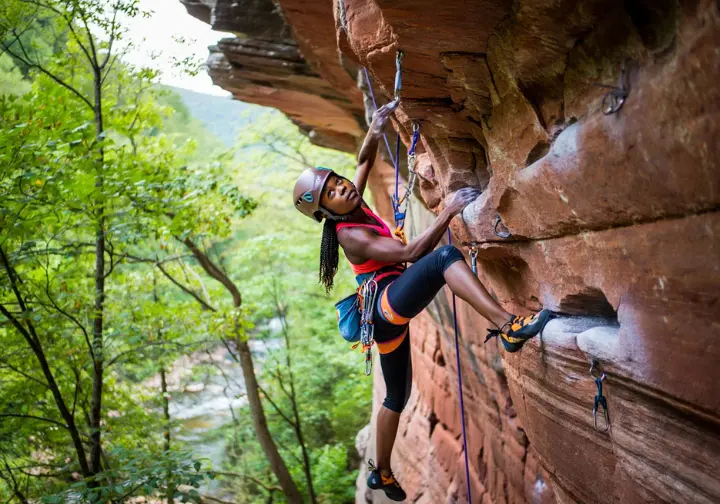
This section explores premier sport climbing destinations in the Eastern and Southern United States, one of the best sport climbing USA regions, renowned for their unique sandstone formations and vibrant climbing communities. We will delve into what makes these areas top choices for climbers seeking memorable routes and experiences.
Red River Gorge, Kentucky: A Sandstone Paradise
The Red River Gorge, affectionately known as “The Red,” stands as a premier sport climbing mecca in the eastern United States. The Red River Gorge sport climbing experience is celebrated for its steep, pocketed Corbin Sandstone and impressively overhanging walls that truly test a climber’s endurance. At the heart of its culture is Miguel’s Pizza, the undisputed cultural and social hub, offering camping, gear, and a strong sense of camaraderie for climbers. For comprehensive Red River Gorge climbing information, Mountain Project is a great resource, and don’t miss checking out Miguel’s Pizza official site.
The climbing is predominantly on overhanging Corbin Sandstone, which features abundant pockets, jugs, and slopers, demanding strong forearms and significant endurance from those who tackle its routes. The Red offers a wide spectrum of grades, from 5.6 to 5.14+, but it particularly excels in high-quality routes ranging from 5.10 to 5.13. Optimal climbing seasons are Autumn (October-November) and Spring (March-May), though summer can be hot and humid, while winter sometimes offers clear, sunny climbing days. Access to the climbing areas is typically via driving and then hiking within the Daniel Boone National Forest, with various camping options and cabin rentals available nearby. If you’re considering a visit, planning a trip to Red River Gorge will require some research. The Red River Gorge Climbers’ Coalition (RRGCC) is vital for access, owning and managing significant climbing areas like the Pendergrass-Murray Recreational Preserve (PMRP) and the Miller Fork Recreational Preserve (MFRP). Local ethics generally favor lowering off anchors due to the overhanging nature of the rock; climbers should always check anchor quality before committing to a climb.
New River Gorge, West Virginia: Wild and Wonderful Sandstone
The New River Gorge (NRG) in West Virginia is a world-class climbing destination, known for its exceptionally hard Nuttall Sandstone cliffs. This rock is often compared to Yosemite granite in terms of hardness and quality. With over 3,000 routes, NRG offers a diverse range of climbing styles, from technical slabs to powerful overhangs and crack climbing, all set within a beautiful and wild landscape. You can find an excellent guide to climbing at The New River Gorge from the American Alpine Club, and the climbing at New River Gorge National Park Service website offers official information.
The climbing here is on hard, featured Nuttall Sandstone, which often requires creative problem-solving and thoughtful movement. It’s commonly advised to “chase stars, not grades,” emphasizing the quality of the climb over its numerical difficulty. NRG spans all grades from 5.7 to 5.15a, with a majority of its sport routes falling in the 5.10 to 5.12 range. The prime seasons for climbing are Fall (September-October) and Spring (April-June), but year-round climbing is possible by choosing crags with appropriate sun or shade exposure. Access is via various trailheads within the New River Gorge National Park and Preserve, with camping available at the American Alpine Club campground and other options in the nearby town of Fayetteville. For those exploring New River Gorge climbing, understanding local stewardship is key. The New River Alliance of Climbers (NRAC) is active in anchor replacement and advocacy. Ethics include stick-clipping high first bolts, lowering from anchors, no fixed “project draws” within the National Park, and obtaining permits for any new fixed protection.
Horseshoe Canyon Ranch, Arkansas: Southern Sandstone Hospitality
Horseshoe Canyon Ranch (HCR) in Arkansas stands out as a premier destination for sport climbing, bouldering, and traditional climbing, particularly known for its user-friendly sandstone and “climbing resort” amenities. This privately-owned ranch offers highly accessible climbing with short approaches, making it an ideal spot for all levels, especially families looking for an accommodating outdoor experience. For a broader perspective, Climbing Magazine offers a guide to climbing in Arkansas. The Horseshoe Canyon Ranch official website provides specific details about the ranch.
The climbing at HCR is on “bulletproof” sandstone, featuring a variety of holds like chickenheads, incuts, crimps, jugs, and plates. Routes are typically on vertical to slightly overhanging walls. HCR is renowned for its excellent selection of moderate sport climbs, particularly in the 5.6 to 5.10 range, but it also boasts challenges up to 5.14. The best times to visit are Spring (March-May) and Fall (September-November); summer is generally hot and humid, while winter can be cold. Located near Jasper, climbers pay daily access and/or camping fees. On-site lodging options include camping, cabins, and lodge rooms. The ranch also provides amenities such as restrooms, showers, a Trading Post, a restaurant, Wi-Fi, a zipline, and Via Ferrata routes. A strict “DOGS NOT ALLOWED” policy is enforced. HCR is also famous for hosting the annual “24 Hours of Horseshoe Hell” climbing competition.
Limestone Legends: Mexico & US Mountain West Sport Climbing
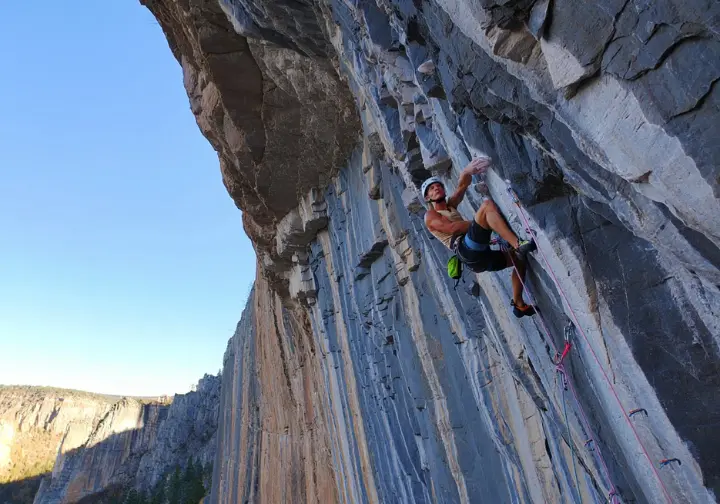
This section highlights world-renowned limestone sport climbing destinations in Mexico and the US Mountain West. These areas are known for their towering walls, technically demanding climbing routes, and unique climbing styles that attract climbers from across the globe.
El Potrero Chico, Mexico: Limestone Walls Stretching to the Sky
El Potrero Chico, located near Hidalgo, Mexico, is internationally acclaimed for its exceptionally long, bolted multi-pitch sport routes that ascend towering limestone walls. This characteristic makes it a true bucket-list destination for many climbers. The dramatic canyon scenery alone provides a breathtaking backdrop to any climbing adventure here. For an overview, Mountain Project has extensive El Potrero Chico climbing overview information, and Rock About offers additional El Potrero Chico rock climbing information.
The climbing is on predominantly solid, sharp, and featured limestone. While El Potrero Chico is best known for its multi-pitch sport routes, some of which extend for over 20 pitches, there are also many single-pitch sport climbs available. It’s particularly celebrated for its moderate (5.8-5.10) to advanced (5.11-5.12) multi-pitches, though climbs up to 5.14 can be found. Mid-December to March is the most popular season, but year-round climbing is possible by strategically chasing sun or shade. Located near Monterrey, access is typically via a flight to MTY followed by a taxi or shuttle, or by driving from the US border. Various climber-specific accommodations, such as campgrounds and casitas, are available. Due to rockfall potential, helmets are essential, especially on multi-pitch routes. Many climbers should also consider the importance of quickdraws for long routes, and it’s recommended to bring a 70m rope, 15-25 quickdraws, and some alpine draws.
Rifle Mountain Park, Colorado: The Limestone Laboratory
Rifle Mountain Park in Colorado is often referred to as a “limestone laboratory” where the limits of hard sport climbing have historically been pushed. It’s known for its steep, powerful routes on often-slippery limestone, offering a specialized climbing experience for any Colorado climber. The unique character of the rock, its distinct holds, and the techniques required, such as frequent kneebars, define climbing in Rifle. Climbing Magazine offers insights into Rifle Mountain Park sport climbing. Learning what makes a world class climbing area can give context to Rifle’s status as a world-class sport area.
The climbing is on limestone characterized by deep caves, imposing bulges, and long, overhanging walls. The rock features notorious “Rifle slopers,” as well as pinches, crimps, pockets, and tufas; proficiency with kneebars is often essential for success on many routes. Rifle hosts over 500 routes, with grades ranging from 5.7 to 5.15a. It is particularly famous for its world-class concentration of sport routes in the 5.12 to 5.14+ range, but also offers good selections for those climbing 5.9 to 5.11a. Late summer through autumn typically offers the best conditions for this technical climbing. Located in the heart of the Rocky Mountain region, near the town of Rifle, CO, most crags are roadside or have short approaches. Paid camping is available within the canyon on a first-come, first-served basis, with free dispersed camping options beyond the main canyon area. For those training for powerful limestone routes, Rifle provides ample challenge. The Rifle Climbers Coalition (RCC) manages access and bolting, with permits now required for new route development. The area also has a history of ethical debates surrounding practices like red-tagging routes and the use of kneebars.
Shelf Road, Colorado: Vertical Limestone Playground
Shelf Road, situated in south-central Colorado, is a popular sport climbing destination cherished for its sunny exposure and abundant, well-bolted routes on vertical limestone. The Shelf Road sport climbing often serves as a go-to spot when other Colorado crags are snowbound or too cold. The Bureau of Land Management (BLM) manages the area and has developed climber-specific campgrounds to accommodate visitors. Information on Shelf Road BLM managed sites is available on their website, and a Shelf Road Rock guidebook can be purchased for detailed route information.
The climbing at Shelf Road is on extensive limestone bands found above the historic Shelf Road itself. Routes are predominantly vertical to slightly less than vertical, featuring pockets, edges, and engaging technical face climbing that demands good footwork and balance. With nearly 1,000 routes, mostly sport climbs ranging from 5.7 to 5.13, Shelf Road has a particularly high concentration of quality moderate climbs in the 5.8 to 5.11 range, perfect for 5.9-5.11 climbing enthusiasts. The best seasons to climb are fall, winter, and spring due to its sunny aspect; summers can be very hot and less ideal. Located north of Cañon City, access is via Fremont County Road 9, a dirt road that is usually passable for 2WD vehicles. The BLM operates the Sand Gulch and The Banks Campgrounds for visitors. Standard sport climbing ethics apply, and the Pikes Peak Climbers Alliance may be involved in stewardship efforts in the climbing area. For this type of vertical face climbing, choosing shoes for technical face climbing can make a difference.
Unique Rock & High Altitude Havens: Tuff, Cobbles & Dolomite Sport Climbing

This section dives into sport climbing destinations famed for their distinctive rock types like volcanic tuff and conglomerate cobbles, or their invigorating high-altitude dolomite settings offering excellent high elevation sport. These areas offer truly unique climbing challenges and memorable experiences due to their geology.
Smith Rock, Oregon: Birthplace of American Sport Climbing
Smith Rock State Park in Oregon is revered as the birthplace of modern American sport climbing. The Smith Rock sport climbing legacy began here in the early 1980s when pioneers like Alan Watts established some of the first bolted routes on its iconic volcanic tuff spires. The park’s dramatic scenery and the consistently high-quality climbing continue to attract visitors from around the globe, cementing its legendary status. For official information, visit the Smith Rock State Park official information page, and for route details, check Smith Rock climbing route information on Mountain Project.
The primary rock type is welded tuff, which offers excellent friction and features small edges, pockets, and nubbins, leading to technical, balance-intensive face climbing on impeccable rock. Columnar basalt is also found within the park, offering a different climbing experience. Smith Rock boasts routes from 5.4 to 5.14c, catering to climbers of all abilities. It is renowned for both its multi-pitch moderates and its groundbreaking hard sport climbs. Spring (April-May) and Fall (September-October) are the prime climbing seasons. Summers are very hot, while winters can be cold but often provide climbable days with fewer crowds for the determined climber. A day-use parking permit is required to visit. Walk-in bivouac camping (tents only, first-come, first-served) is available within the park; the nearest RV camping is at Skull Hollow Campground. Given the nature of climbing, understanding the importance of wearing a climbing helmet is always relevant. Smith Rock is managed by Oregon State Parks. Climbers should be aware that older fixed hardware may exist and should always inspect bolts. Stick-clips are advisable for high first bolts on many routes. It’s important to stay on trails to protect the fragile desert environment, and be mindful of seasonal closures (typically January 15 – August 1) to protect nesting raptors.
Maple Canyon, Utah: The Unique Cobble Puzzle
Maple Canyon, located in central Utah, offers a truly unique rock climbing experience on conglomerate rock. Here, climbers navigate walls embedded with rounded river cobbles of various sizes, creating a distinctive three-dimensional climbing puzzle. This unusual style attracts those seeking novel challenges and a break from more traditional rock types. For detailed information, see Maple Canyon climbing details on Mountain Project and the Maple Canyon guidebook information also available there.
Climbing in Maple Canyon is exclusively on conglomerate, involving pulling, palming, and manteling on embedded cobbles that can range from small pebbles to large boulders. The routes are often on steep to overhanging terrain, demanding power, body tension, and creative movement to decipher the sequences of these rock climbs. Maple hosts over 700 routes, mostly sport, with grades from 5.6 to 5.13+, and many quality climbs can be found in the 5.10 to 5.12 range. Summer is a popular season due to the canyon’s higher elevation (7,000-8,000 feet), which provides cooler temperatures compared to other Utah crags at different elevations; spring and fall are also excellent times to visit. Access is via a paved road that eventually turns to dirt. Camping is available at the Maple Canyon Campground (USFS, fee required), and a day-use fee applies for climbing in the National Forest portion of the canyon. The unique nature of the climbing makes understanding different types of climbing holds particularly interesting here. The area is primarily managed by the Uinta-Wasatch-Cache National Forest. Some areas, such as Box Canyon, are on private land and have different rules and fees. Climbers should also be aware of seasonal raptor closures, typically for Golden Eagles from March to August. This destination is certainly elevation dependent for comfortable conditions.
Wild Iris, Wyoming: High Altitude Dolomite Gems for Sport Climbing
Wild Iris, perched at 9,000 feet near Lander, Wyoming, is a cherished summer sport climbing gem. It’s beloved for its cool temperatures and beautiful white, pocket-marked dolomite cliffs set amidst picturesque aspen and pine forests. This wild rid(e) offers a remote, “wild” feel and primitive camping appeal to those seeking a rugged, self-sufficient climbing experience away from crowds. You can find a Wild Iris climbing area overview on Mountain Project. For broader context, understanding sport climbing safety basics is always a good idea.
The climbing at Wild Iris is on dolomite, a type of limestone, characterized by abundant pockets and some edges. Routes here are typically short, bouldery, and powerful, demanding strong fingers and good climbing technique to navigate the often-cryptic sequences. Around 380 routes exist, mostly sport, with grades ranging from 5.4 to 5.14d. There is a good concentration of quality climbs in the 5.10 to 5.12 range. The primary season is summer, from early June to late fall. The high elevation means pleasant temperatures for climbing, but rapid weather changes, including wind and storms, are common, so be prepared. Access is via Limestone Road, which is a dirt road. Free, dispersed camping is available with limited facilities, including vault toilets and bear boxes, but no potable water. For this type of rock, choosing the right chalk for dolomite pockets can be a factor. The area is likely managed by the USFS (Shoshone National Forest). Climbers should be prepared for changing weather, electrical storms, and the presence of rattlesnakes. Lander, the nearby town, is a vibrant climbing hub and climber hotspot, home to the International Climbers’ Festival.
Ten Sleep Canyon, Wyoming: Dolomite Dreams & Development Debates
Ten Sleep Canyon, nestled in Wyoming’s Bighorn Mountains, is a major summer sport climbing destination, drawing climbers with its miles of pocketed dolomite cliffs and generally friendly bolting. The area boasts a rich climbing history and a vast number of routes. However, it has also faced controversy regarding route manufacturing, including chipping and gluing holds, which has led to some USFS closures in specific areas. For more information, Climbing Magazine offers Ten Sleep Wyoming climbing information, and you can check for Bighorn Climbers’ Coalition updates on their website.
The climbing in Ten Sleep is on dolomite, featuring abundant pockets, crimps, and edges. It typically involves technical face climbing on vertical to slightly overhanging walls. Over 800 bolted routes exist, often with “friendly” bolting that can make it a good place for pushing grades for the aspiring climber. Summer, particularly June through August, is the prime season for many climbs. Many of the crags go into the shade around 2 p.m., allowing for comfortable afternoon and evening climbing sessions even on warmer days. Located east of Ten Sleep, WY, along US Hwy 16, the canyon is quite accessible. Free dispersed camping can be found on Leigh Creek Road, and USFS campgrounds are also available in the vicinity. If you’re planning your Ten Sleep sport climbing trip, being aware of local issues is important. The Bighorn Climbers’ Coalition (BCC) is the key local organization for access, conservation, and education. Crucially, climbers MUST be aware of ongoing access issues and closures in certain areas (e.g., Funky Town, Trump Tower) due to past hold manufacturing. Unauthorized route development is prohibited, and all visitors should practice Leave No Trace principles meticulously for all their outdoor adventure opportunities.
Coastal Granite, Schist Classics & Desert Sandstone Sport Climbing
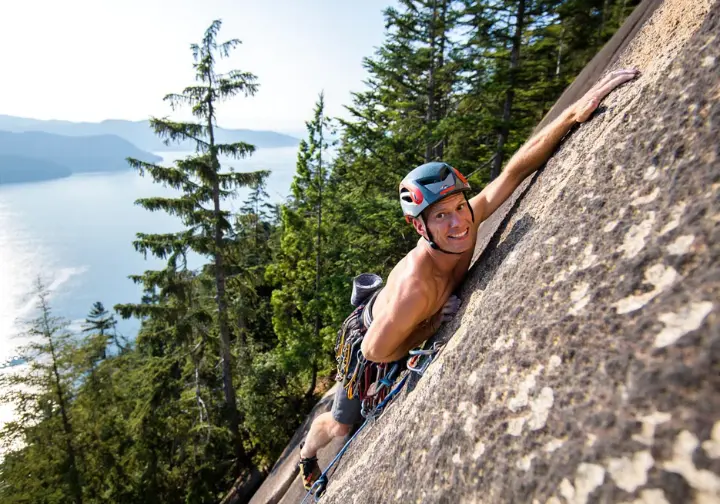
This section explores a diverse trio of top North American sport climbing destinations: the granite mecca of Squamish, the unique schist of Rumney, and the vast desert sandstone of Red Rock Canyon. Each offers distinct rock, characteristic styles of movement, and unforgettable climbing experiences that draw adventurers from all over.
Squamish, British Columbia, Canada: Granite Sport Amongst Giants
While globally celebrated for trad crack climbing on magnificent granite domes, Squamish, BC, also boasts a significant and high-quality sport climbing scene, offering a mix of sport climbing—trad environments. Key areas include Cheakamus Canyon (often called “Chek”), Murrin Park, and various crags along the Sea-to-Sky corridor, such as Area 44. This diversification of climbing styles has broadened Squamish’s appeal to a wider range of climbers. For those looking for guidebooks, the Squamish rock climbs guidebook is a valuable resource, and theCrag offers Cheakamus Canyon sport climbing details online.
The rock in Squamish is predominantly granite. Cheakamus Canyon features compact granite that is often vertical to overhanging, offering powerful or technical sequences, and some areas even provide protection from light rain. Murrin Park provides featured slabs, vertical faces, and some overhangs, while Area 44 also contains vertical to overhanging sport routes. Sport climbing is available across a wide grade range. Chek hosts some of Canada’s hardest sport climbs, reaching up to 5.14c, but also has a wealth of routes between 5.9 and 5.13. Murrin Park offers climbs from 5.7 to 5.12+. Area 44 features routes from 5.7 to 5.11+ and harder. Summer (June to September) is the main climbing season. Cheakamus Canyon can offer options even during light rain, extending the climbing possibilities. Camping can be a significant issue in the area; “wild” or unmanaged camping is prohibited in the Squamish District. Designated campgrounds include Stawamus Chief Provincial Park, Mamquam River, and the Chek Canyon Recreation Site (which is free but has rough access). The Squamish Access Society (SAS) is the primary local advocacy group working to maintain access for climbers.
Rumney, New Hampshire, USA: East Coast Schist Classics
Rumney, New Hampshire, is widely regarded as the undisputed king of Northeast sport climbing, drawing climbers from all over to its unique schist rock and densely packed, high-quality routes. The rock’s distinct “grain,” often likened to wood, creates climbing on engaging features such as arêtes, grooves, dikes, and corners, offering a style not commonly found elsewhere in these White Mountains. For up-to-date Rumney climbing conditions and routes, Mountain Project is an excellent resource. You can find Rumney Climbers Association information on their official website.
The climbing at Rumney is on schist, a metamorphic rock that provides varied, technical holds on prominent features. This leads to engaging sequences that can range from slabby and delicate slab climbing to steeply overhanging and powerful steep climbing. Rumney offers excellent quality routes across all grades, from 5.3 to an impressive 5.15a, making it a destination for all abilities. Fall is legendary at Rumney, with optimal temperatures, low humidity, and stunning foliage making it the most popular season. However, spring and summer are also viable times to visit this climber hotspot. Access to the crags is via Buffalo Road. Parking is a significant issue, especially on weekends, and carpooling is essential. Parking directly on Buffalo Road is strictly prohibited and enforced. The Rumney Climbers Association (RCA) is a very active organization involved in land acquisition (often transferring land to the White Mountain National Forest), trail work, hardware replacement, and climber education, playing a vital role in preserving this classic sport area.
Red Rock Canyon, Nevada: Desert Sandstone Sport Adventures
Red Rock Canyon National Conservation Area, located just west of Las Vegas, is an iconic climbing destination and one of the top destinations in North America, renowned for its massive, brilliantly colored Aztec Sandstone cliffs. This area offers vast sport climbing opportunities alongside its world-famous trad routes and traditional climbs. The Calico Hills area, in particular, boasts a high concentration of entry-level and moderate sport routes, perfect for the entry-level sport leader. For comprehensive information, Jerry Handren’s Red Rock Canyon definitive guidebook is highly recommended, and the Red Rock Canyon NCA official site offers park details.
The climbing is on Aztec Sandstone, which can vary in texture. Sport routes range from featured faces in Calico Hills to steeper, powerful lines on bullet-hard, dark varnished stone on its steep walls, often involving edges, pockets, and friction-dependent moves. With over 2,300 routes, Red Rock spans all grades, from easy 5.something to 5.14+. There is substantial sport climbing from 5.7 to 5.11, as well as many harder options for the seasoned climber. The best seasons to climb are fall, winter, and spring; summer is extremely hot and generally avoided by climbers (though some visit Mount Charleston for summer Mount Charleston relief at higher elevations). A timed entry reservation, obtainable through Recreation.gov, is required for the Scenic Drive from October 1st to May 31st, between 8 a.m. and 5 p.m.. If you are planning your Red Rock climbing trip, this is a key logistical detail. The official BLM Red Rock Campground is located outside the Scenic Drive. Las Vegas, being very close, offers many hotel and lodging options. Important ethics to observe include avoiding climbing on wet sandstone, as it weakens significantly and can break. Adherence to Leave No Trace principles is also critical. The Southern Nevada Climbers Coalition (SNCC) is the local advocacy group, a supportive climbers coalition, working to protect access and the climbing environment.
Masterminding Your Epic Climbing Journey & Climbing Responsibly
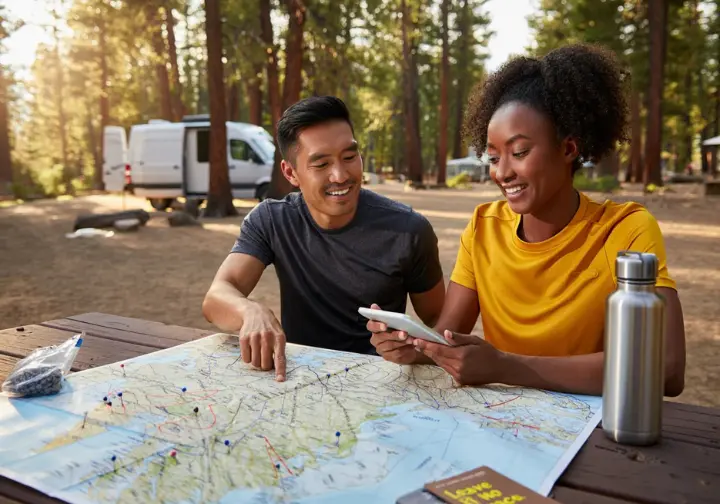
This section provides essential advice for planning a multi-crag North American sport climbing road trip, including big road trips or a cross-country road trip, emphasizing seasonal strategies and the critical importance of responsible climbing practices. Adopting these will help preserve these cherished destinations for future generations of climbers.
Planning Your Ultimate North American Climbing Road Trip
Strategic planning for a multi-crag road trip often involves chasing optimal weather conditions. Consider desert southwest destinations like Red Rock Canyon or Shelf Road during the cooler months of fall, winter, and spring. Higher elevation crags such as Wild Iris, Ten Sleep Canyon, and Maple Canyon are typically best visited in the summer to escape the heat found elsewhere; conditions are often elevation dependent. For information on climbing advocacy and access, the Access Fund is a key resource.
Eastern Gorges like the Red River Gorge and New River Gorge generally offer their best conditions in spring and fall. Meanwhile, Squamish in British Columbia sees its main climbing season during the summer months. Always consult guidebooks and online resources like Mountain Project for current conditions, and keep a close eye on weather forecasts when finalizing your plans for these trips. Building flexibility into your itinerary is crucial, as unpredictable weather and potential crowds at popular crags can necessitate backup plans. A holistic approach considers not just seasons, but also access rules (public versus private land), local ethics, and conservation needs for a successful and responsible trip to make it a great trip.
The Responsible Climber’s Creed: Leave No Trace & Support LCOs
Adhering to Leave No Trace (LNT) principles is fundamental for any climber. This includes planning ahead and preparing adequately, traveling and camping on durable surfaces, disposing of waste properly—which means packing out everything, including human waste where required. Further LNT principles involve leaving what you find, minimizing campfire impacts (or forgoing them altogether), respecting wildlife, and being considerate of other visitors while enjoying these outdoor adventure opportunities. Understanding rock climbing ethics and rules is a good starting point.
Understanding and respecting the specific access conditions for each crag is vital. This includes knowing land ownership (public or private), whether permits or fees are required, and being aware of seasonal closures, such as those for raptor nesting. Supporting Local Climbing Organizations (LCOs) and national advocacy groups like the Access Fund’s role in conservation or the American Alpine Club through membership, donations, or volunteering directly contributes to maintaining access, conserving environments, and replacing aging hardware like bolts. Active engagement positions climbers not just as users of these resources, but as vital stewards and advocates for their protection when they travel to these places.
Essential Resources for Your North American Climbing Adventure
Specific, up-to-date guidebooks are crucial for each climbing area you plan to visit; this guide has recommended representative titles for each featured destination in their respective sections. Online platforms such as Mountain Project are invaluable for accessing up-to-the-minute route information, current conditions reports from other climbers, and community discussions regarding various crags across the continent. These resources are very helpful when transitioning to outdoor sport climbing resources.
Always check the websites of relevant Local Climbing Organizations (LCOs) and the land managing agencies (e.g., National Park Service, US Forest Service, Bureau of Land Management, State Parks) for the latest access alerts, closures, and specific regulations before visiting any crag. Key national organizations to be aware of for resources, advocacy, and information include the Access Fund, the American Alpine Club (AAC), and the American Mountain Guides Association (AMGA) in the USA. In Canada, look to Climbing Escalade Canada (CEC) for Climbing Escalade Canada programs and the Alpine Club of Canada (ACC). In Mexico, the Federación Mexicana de Deportes de Montaña y Escalada (FMDMYE) is the primary body for climbers.
Conclusion: Your Next Adventure Awaits
North America presents an unparalleled tapestry of sport climbing experiences, offering a lifetime of adventure for dedicated climbers across diverse rock types and breathtaking landscapes. From the steep sandstone of the Red River Gorge to the towering limestone of El Potrero Chico and the technical tuff of Smith Rock, the opportunities for any sport climber are boundless.
It is paramount to explore these incredible destinations safely and responsibly. This involves meticulous preparation, a commitment to understanding and adhering to local ethics and local climbing etiquett, and a dedication to minimizing environmental impact wherever you climb. Each area has its own unique considerations, and being a conscientious visitor ensures these places remain special.
Furthermore, supporting local and national climbing organizations is crucial for preserving access and conserving these cherished landscapes for future generations of climbers. Their work on the ground, from trail maintenance to advocacy, is what allows us to continue enjoying these crags. May your climbing adventures be safe, memorable, and respectful of the magnificent places you visit, contributing positively to the ever-evolving climbing community.
Frequently Asked Questions about Top Sport Climbing Destinations in North America
What are some key factors to consider when choosing a sport climbing destination from this list? >
How important is it to check local ethics and access information before visiting a crag? >
What type of rock is most common for sport climbing in North America based on these destinations? >
Are there any beginner-friendly sport climbing destinations highlighted in this guide? >
We are a participant in the Amazon Services LLC Associates Program, an affiliate advertising program designed to provide a means for sites to earn advertising fees by advertising and linking to Amazon.com. As an Amazon Associate I earn from qualifying purchases. We also participate in other affiliate programs. The information provided on this website is provided for entertainment purposes only. We make no representations or warranties of any kind, expressed or implied, about the completeness, accuracy, adequacy, legality, usefulness, reliability, suitability, or availability of the information, or about anything else. Any reliance you place on the information is therefore strictly at your own risk. Additional terms are found in the terms of service.



